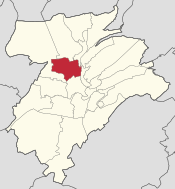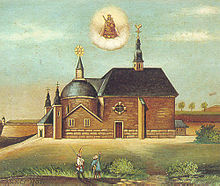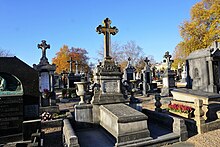Limpertsberg
Limpertsberg Lampertsbierg (Luxembourgish) | |
|---|---|
 Limpertsberg is one of 24 quarters in Luxembourg City | |
| Coordinates: 49°37′15″N 6°07′18″E / 49.62083°N 6.12167°E | |
| Country | Luxembourg |
| Commune | Luxembourg City |
| Area | |
• Total | 1.5707 km2 (0.6065 sq mi) |
| Population (31 December 2023)[2] | |
• Total | 11,424 |
| • Density | 7,300/km2 (19,000/sq mi) |
| Nationality | |
| • Luxembourgish | 27.56% |
| • Other | 72.44% |
| Website | Limpertsberg |
Limpertsberg (Luxembourgish: Lampertsbierg, pronounced [ˈlɑmpɐtsbiəɕ] ⓘ) is a quarter in north-western Luxembourg City, in the centre of Luxembourg.
As of 31 December 2023, Limpertsberg had a population of about 11,424 inhabitants.[2]
Overview
In the south, on the border with the main city is the Glacis, a large open air parking lot which hosts the annual Schueberfouer fair, the largest fair in the country. Next to the Glacis is the Grand Théâtre de Luxembourg.[3]
Limpertsberg's Notre-Dame Cemetery has a Monument de la résistance et de la déportation (Monument of the national resistance and deportation).[4] The cemetery features the bronze sculpture of The Political Prisoner by Luxembourg's best-known sculptor Lucien Wercollier. The Limpertsberg bronze is one of three casts of the sculpture, with the other two at the Musée national de la résistance (National Resistance Museum) in Esch-sur-Alzette and the National Monument to the Resistance and to the Deportation at Notre-Dame cemetery in Luxembourg City.
To the south east is another iconic landmark, the Grand Duchess Charlotte Bridge, also known as the Red Bridge due to its colour.[5] It connects Limpertsberg to the European district of Kirchberg, passing over the City quarter of Pfaffenthal and the Alzette river.
Limpertsberg also has several educational institutions such as, parts of the University of Luxembourg, the Lycée de garçons (LGL), the Lycée Robert Schuman, the Lycée Vauban, the Lycée Technique des Arts et Métiers, the Lycée Technique du Centre, the Lycée Technique Michel Lucius, the French school as well as the Waldorf school.
The district also houses St Joseph's Roman Catholic church completed in the Neo-Romanesque style in 1913.[6]
History
In the Middle Ages, the area of the current Limpertsberg quarter had a forest. John the Blind, King of Bohemia and Count of Luxembourg, mentioned a new mill "under the forest Lymperich" in a legal document in 1314, the first historical mention of Limpertsberg.[7] A 1411 agreement between Wenceslas II and an alderman similarly refers to Limpertsberg as being a wooded area.[7]

During the time of the fortress, Limpertsberg was predominantly agricultural in nature, its plateau's image being marked by fields and gardens.[7] The fortress's regulations forbade any significant construction on the land in front of the fortifications.[7] The Prussian law of 1827/28 for the lower Limpertsberg area only permitted light wooden buildings.[7] However, the most important building of modern Limpertsberg had by then long since ceased to exist.

The chapel of Notre-Dame at the crossing between the current Avenue de la Faiencerie and the Allée Scheffer had been constructed from 1624 to 1627 at the instigation of the Jesuit priest Jakob Brocquart, and was generously endowed by several rich urban nobles and citizens.[7] Within a short amount of time, this chapel, with the statue of Mary the Comforter of the Afflicted, developed into the central Marian shrine of Luxembourg, meaning that it had to be expanded already in 1640.[7] The shrine to the Virgin Mary was torn down in 1796 by French Revolutionary troops; only a year previously, it had been turned into a garrison slaughterhouse.[7] Today, a bronze memorial plaque donated by the Lampertsbierger Syndikat in 1935 and designed by local artist Michel Haagen, serves as a reminder of the former "Glaciskapelle" ("Glacis chapel").[7][note 1] In 1691, the chapel cemetery (Kapellekiirfecht) had been inaugurated behind the chapel, which gradually developed into the present-day Notre-Dame Cemetery, especially since 1778 when the city parish church of St. Nicholas was dismantled and the city's main cemetery was relocated to Notre-Dame. Although the official name for this is the "Cimetière Notre-Dame", in common parlance the name "Niklooskiirfecht" is still used today. Near the cemetery, 7 rebels of the Kleppelkrich were executed by firing squad on 8 January 1799. Their leader Michel Pintz was executed on 20 May of the same year by guillotine. A commemorative stone serves as a reminder of this event, made by Edmond Lux, and installed in front of the cemetery in 1974 at the instigation of the publisher François Mersch. The new Glacis chapel, endowed by Bishop Nicolas Adames and designed by the state architect Charles Arendt, was completed in 1885. In the first years of the 20th century, it temporarily served as a parish church to the rapidly increasing population of Limpertsberg.
By necessity, Limpertsberg could not begin its actual development into a residential and education district until after the dismantlement of the fortress from 1867. Only few houses or residents of Limpertsberg are mentioned historically in the era of the fortress. The siege map of 1795 does not mention one single house on the whole plateau. For strategic reasons, all the arable soil had been carried away from the current Glacis during 1745- 48; the goal here was to deprive an attacking force of the opportunity to dig in in front of the fortress, as the French troops under Vauban and Créquy had done in 1684.
Notes
- ^ Located initially on a building opposite the Kleppelkrich monument, it was moved to its current location in 1983
References
- ^ "Limpertsberg". www.vdl.lu (in French). Ville de Luxembourg. Retrieved 29 January 2019.
- ^ a b c "Statistiques sur la Ville de Luxembourg: Etat de la Population - 2023" (PDF). www.vdl.lu (in French). Ville de Luxembourg. Retrieved 15 October 2024.
- ^ Théâtre Municipal de Luxembourg Archived 21 September 2008 at the Wayback Machine
- ^ "Archived copy" (PDF). Archived from the original (PDF) on 24 February 2012. Retrieved 10 November 2009.
{{cite web}}: CS1 maint: archived copy as title (link) - ^ "h2g2 - The Bridges of Luxembourg - Edited Entry". h2g2 The Hitchhiker's Guide to the Galaxy: Earth Edition. Archived from the original on 18 September 2020. Retrieved 8 September 2018.
- ^ "Eglise pasoissiale du Limpertsberg" (PDF). Onsstad.vdl.lu (in French). 1985. Retrieved 3 February 2017.
- ^ a b c d e f g h i Kunnert, Jemp (1985). "Historischer und kultureller Limpertsberg" (PDF). ons stad (in German) (18): 2–7.

